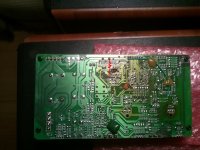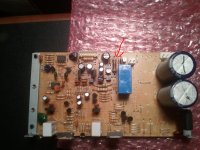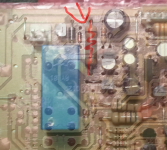I recently bought a pair of Infinity RS8a speakers with active subs off CL for $70 and one of the Subs was dead. I pulled them apart and it appears that a resistor got fried (See attached Pictures). Im going to replace the 8ohm resistor but and I was thinking of using an ever higher rated one if I could, I'm guessing the one installed is probably a 2Watt. Is ceramic or carbon better in this application?
Since I'm going to need to order the resistor online i wanted to make sure I ordered some other components just in case its not just the resistor. I dont have an ESR meter so I cant check the caps to see if the are any good, should I just buy a new set just in case? That black diode seems like it could potentially be damaged when that resistor got overloaded.
Looking at the discoloration on the board it appears to me that the 2 transistors at the bottom are heating up quite a bit, is that an area that I should add heatskins to? Should I consider replacing them transistors?
I haven't been able to find any schematics for this unit so I'm kind of blind in terms or how its supposed to work but I do have a working opposite side speaker that I could use as a troubleshooting aid.
This is my first attempt at amplifier repair and all suggestions appreciated any areas that I should also check that Ive overlooked would be very much appreciated.
Quick Summary of questions:
1) Should I replace the resistor with a higher rated one?
2) Ceramic or Carbon Resistor?
3) Replace electrolytic caps?
4) Replace the black Dodie? Replace any other diodes?
5) Add Heatsinks to the transistors? Replace them?
Since I'm going to need to order the resistor online i wanted to make sure I ordered some other components just in case its not just the resistor. I dont have an ESR meter so I cant check the caps to see if the are any good, should I just buy a new set just in case? That black diode seems like it could potentially be damaged when that resistor got overloaded.
Looking at the discoloration on the board it appears to me that the 2 transistors at the bottom are heating up quite a bit, is that an area that I should add heatskins to? Should I consider replacing them transistors?
I haven't been able to find any schematics for this unit so I'm kind of blind in terms or how its supposed to work but I do have a working opposite side speaker that I could use as a troubleshooting aid.
This is my first attempt at amplifier repair and all suggestions appreciated any areas that I should also check that Ive overlooked would be very much appreciated.
Quick Summary of questions:
1) Should I replace the resistor with a higher rated one?
2) Ceramic or Carbon Resistor?
3) Replace electrolytic caps?
4) Replace the black Dodie? Replace any other diodes?
5) Add Heatsinks to the transistors? Replace them?
Attachments
Last edited:
Hi,
The resistor has probably fried due to a fault elsewhere, if so,
replacing it won't fix it, and a higher power resistor won't help.
If the other board looks fine, all your symptoms are
due to a fault. You don't fix symptoms, you fix faults.
Faultfinding is a skill some engineers have and some simply don't.
You don't need it to design something, but you do to be able to fix it.
rgds, sreten.
The resistor has probably fried due to a fault elsewhere, if so,
replacing it won't fix it, and a higher power resistor won't help.
If the other board looks fine, all your symptoms are
due to a fault. You don't fix symptoms, you fix faults.
Faultfinding is a skill some engineers have and some simply don't.
You don't need it to design something, but you do to be able to fix it.
rgds, sreten.
Last edited:
sreten:
Agreed, on the fault likely being elsewhere but this fault could have been cause by either a mechanical or design failure. I can't address design failure due to lack of expertise, and schematics (i could generate schematics off the actual board but that's more effort then its worth) . What I'm looking to do is to address the mechanical part of the fault, the simplest way to do that is to replace components with high likelihood of failure. That's what im looking for advice on, what here is likely to fail and cause the resistor to burn up and likely to have failed during burn up.
Agreed, on the fault likely being elsewhere but this fault could have been cause by either a mechanical or design failure. I can't address design failure due to lack of expertise, and schematics (i could generate schematics off the actual board but that's more effort then its worth) . What I'm looking to do is to address the mechanical part of the fault, the simplest way to do that is to replace components with high likelihood of failure. That's what im looking for advice on, what here is likely to fail and cause the resistor to burn up and likely to have failed during burn up.
Hi,
Like I said faultfinding is a skill not all engineers have.
Moaning about poor design and the like doesn't make
any sense if the other board is fine, and FWIW given
one working board, I'd have little problem faultfinding.
What I can't do with is the "something must be bust"
so replace it, will fix it, mentality. Understanding the
original fault is the key to fixing it property, not a
scattergun approach of component replacement.
rgds, sreten.
Like I said faultfinding is a skill not all engineers have.
Moaning about poor design and the like doesn't make
any sense if the other board is fine, and FWIW given
one working board, I'd have little problem faultfinding.
What I can't do with is the "something must be bust"
so replace it, will fix it, mentality. Understanding the
original fault is the key to fixing it property, not a
scattergun approach of component replacement.
rgds, sreten.
Last edited:
TVI: Thanks for the links. I suppose my fuse was the resistor because the I checked the fuses and they were good. My large caps appear undamaged (although its hard to tell for sure without a ESR meter). I was thinking of replacing the small caps first because they are cheap, and have low voltage rating which makes they good candidates for early failure.
Sareten: I think what you are getting at is that I should take apart the other speaker and start measuring voltages to to help isolate the failed component. That is a valid suggestion and I will take your suggestion under consideration. The components are kind of unwieldy and because of the integrated heatsink i was trying to avoid measuring voltages in the powered on state. If you have some suggestions on what areas I should check first though I would much appreciate them.
I was thinking that replacing the usual suspects first before doing more extensive troubleshooting was a going to be the best use of my time, hence why I'm asking what the usual suspects might be.
Sareten: I think what you are getting at is that I should take apart the other speaker and start measuring voltages to to help isolate the failed component. That is a valid suggestion and I will take your suggestion under consideration. The components are kind of unwieldy and because of the integrated heatsink i was trying to avoid measuring voltages in the powered on state. If you have some suggestions on what areas I should check first though I would much appreciate them.
I was thinking that replacing the usual suspects first before doing more extensive troubleshooting was a going to be the best use of my time, hence why I'm asking what the usual suspects might be.
How-to-test-a-capacitor with an Ohmmeter of a Multimeter could give you a basic go no-go test.
The discoloured resistor is inline with the relay energising coil, if it gone open circuit or changed value to much the relay will not be closing, so no output.
If the resistor value has dropped to much it may have taken out the relay coil, so that may need replacing too.
hope this helps
James
The discoloured resistor is inline with the relay energising coil, if it gone open circuit or changed value to much the relay will not be closing, so no output.
If the resistor value has dropped to much it may have taken out the relay coil, so that may need replacing too.
hope this helps
James
Attachments
- Status
- This old topic is closed. If you want to reopen this topic, contact a moderator using the "Report Post" button.
- Home
- Amplifiers
- Power Supplies
- Repairing an Infinity RS8 Power Supply


